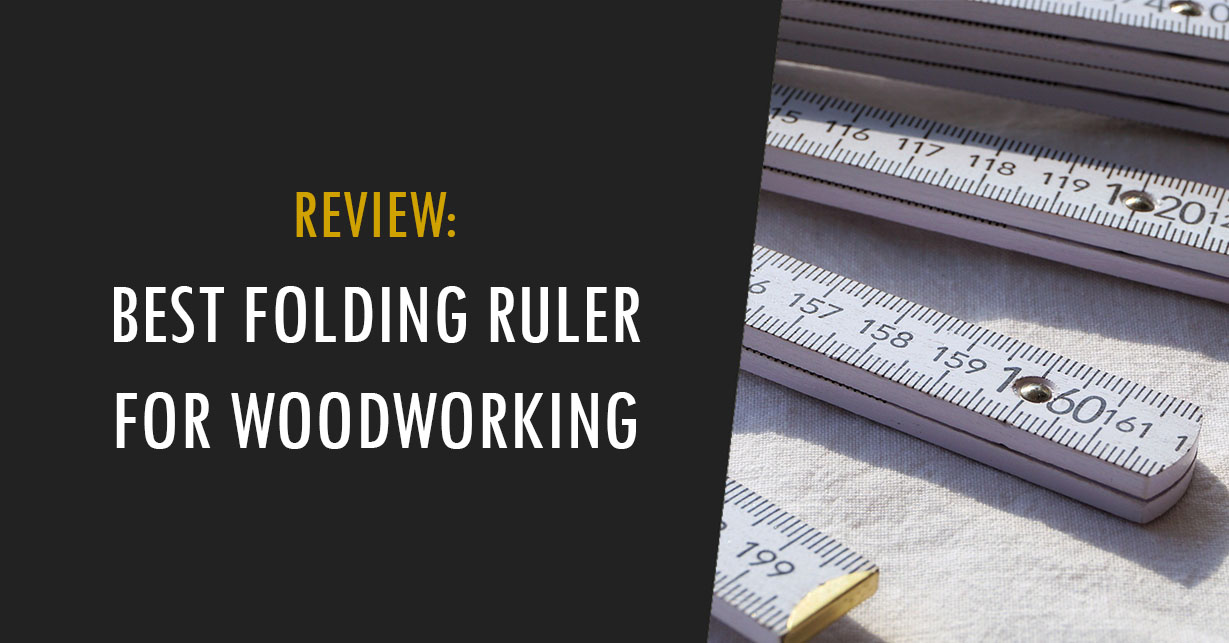A folding ruler is a tool designed to accurately measure lengths and it comes in very handy when using a measuring tape is not practical, such as when measuring a distance ending in a straight angle as using a folding ruler would lead to a much more accurate measurement.
In woodworking, they are ideal as they conveniently fold around almost any angle and make almost any measurement a one-step process which gives them an advantage over a regular ruler or measuring tape. They can also be used to measure 90-degree angles.
There are a few variations of folding rulers, and there are also inside reading and outside reading types. So, which one is the best for woodworking? Let’s take a look:
Best Woodworking Folding Rulers
Lufkin X46SLN Wood Rule
Pros
- Challenging features like long-lasting wood with brass end caps and joints to restrict splintering
- Having markings on both sides and edges
- Slide rule increases to 6ft
Cons
- It comes in inches and not metric
- The product is not painted
Being manufactured by one of the leading hand tool manufacturers globally, the Lufkin X46SLN is made of wood and comes in a 5/8 inches x 6ft, painted with red markings in the front end to record the starting the endpoint. The product consists of both markings and numberings inside the rule, which is categorized as 1/16th inches. At the same time, the slide rule has a grip in the t-slot, which halts at every end to avoid the slide from falling. Overall, the product is easy to use and read and has good value for money and quality.
Product Details:
| Product Dimensions | 1.9 x 0.6 x 8 inches |
|---|---|
| Color | Brown |
| Material | Wood |
| Measurement System | Metric |
| Measurement Accuracy | +/-0.5% |
Klein Tools 911-6 Folding Ruler 6-Foot
Pros
- Made of augmented glass fibers and durable nylon to defiance from chemicals, weather, and wearing
- Very sturdy
- One year warranty
Cons
- Provides only standard marking and no metric
- Not transparent
The Klein Tools 911-6 is an outside reading ruler made from rigid fiberglass, which has black markings on the surface and the center red stud markings after every 16 inches. Also, the measurement markings are on both the sides and edges with imprint graduations on all sides, which is 1/16 inches. The ruler also comes with locking joints and spring hinges which are stainless steel.
Product Details:
| Product Dimensions | 10 x 10 x 10 inches |
|---|---|
| Style | Outside Read |
| Material | Fiberglass |
| Handle Material | Stainless steel |
| Special Features | Locking Joints |
Crescent Lufkin 5/8″ x 6′ Red End Two Way Wood Rule
Pros
- Easier to use compared to standard wood rules
- Incorporates SAE/Metric measuring type
Cons
- Not stain resistant
- Limited lifetime
An exciting feature about the Crescent Lufkin is that it has been designed to measure from right to left and left to right. This product is produced out of wood which comes in a 6′ X 5/8″ red end that can be measured two ways. Moreover, there are marks on both sides for convenient measurement. It also sits flat while measuring and graduates inches, feet, and 1/16th for all edges and sides.
Product Details:
| Product Dimensions | 8 x 2.1 x 0.63 inches |
|---|---|
| Style | Folding |
| Finish | Red |
| Material | Wood |
| Measurement System | Inch |
| Usage | Professional |
Midori Multi Aluminium Ruler 30cm Black
Pros
- Can measure angles due to the protractor facility
- The hinge helps in effortless opening and closing but is also compact enough to support any angle.
- It doesn’t disturb the fidelity of a line when drawn
Cons
- It may not be suitable for people who are used to measuring in cm as the ruler measures in mm.
Apart from being a smooth, mobile, and convenient ruler, Midori multi aluminum ruler is an award-winning product for its design. The ruler is 30 cm, and the millimeter marks are laser-engraved with 0.5mm marks during the initial 5 cm. It also gives a smooth fold with a clasp-click sound while closing and can be used alongside a craft knife. A ruler’s side has zero measurements at the edge, making measuring depths and heights very convenient. Furthermore, this metric measurement type ruler can function as a protractor as its central rotator consists of 15° tick marks.
Product Details:
| Item Weight | 1.28 ounces |
|---|---|
| Product Dimensions | 1.14 x 0.18 x 6.26 inches |
| Color | Black |
WIHA 61606 Composite Laminated Ruler Metric/Inch
Pros
- Defensive steel caps on both ends
- Protects from scratch, chemicals, and water
- It is 40% more firm when expanded
Cons
- May break easily compared to wood
The WIHA 61606 is an outside reading ruler which measures 2m with ½” width and has ten sections. It contains laminated layers which have longitudinal fiberglass tress to guarantee sound and waterproof quality. Moreover, it is wear-free, immune to dirt joints, and has a spring pin to maintain chronic tension. The ruler also holds peak translucence of white and black marking deeply enhanced with protection and has a joint click of 90° and 180°. The metric/inch or two-in-one metric is free of maintenance and won’t rust or whim.
Product Details:
| Item Weight | 5.6 ounces |
|---|---|
| Color | Multi |
| Measurement System | Metric |
How do you use a folding ruler?
Many may assume that folding rulers are complicated to use due to their layers or designs. Here we will discuss how you can use a folding ruler straightforwardly and effortlessly.
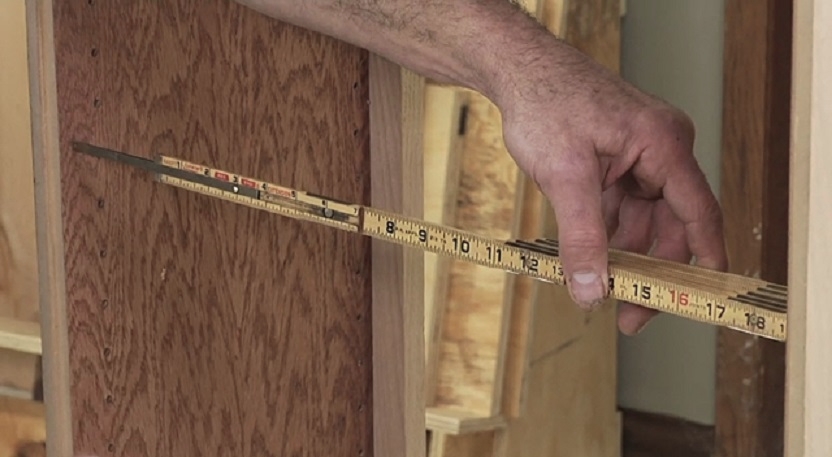
- Begin by holding the folding ruler, clutching the first section of the ruler, and revolving it to 180°. You may discover in some rulers that when reached 180°, it will click or lock. In case it doesn’t, line up the section with the help of the ruler’s remainder.
- Next, revolve the ruler from the following section of 180° to produce a ruler close to three times the dimension of the section’s length. You can continue the same process until the ruler is sufficiently spread to extract the required measurement.
- Set the ruler’s unraveled length as opposed to the object to ensure straight line measurement.
- Even the end of the ruler with one of the object’s ends and with the assistance of the ruler’s fixed point, straighten up the other end of the object. The process will help you document the measurement specified by the fixed point. In the end, double-check to make sure accurate measurements have been taken.
Why is a folding ruler important for woodworking?
There are many other tools for measuring, but what makes a folding ruler relevant to help you in your woodworking project? One of the most significant factors to including folding rulers in a woodworking project is that they can calculate lengthy proportions because there is no hook at the end of the ruler, making the calculations more precise. Due to the absence of the hook, a firm metal cap is attached to the ruler’s end, making measurement more accessible and free precisely when measured against an object. Also, the incorporation of the sliding rule makes measuring the intensity and internal distances more convenient.
What is the best material for a folding ruler?
Years back, most of the folding rulers were made out of wood. But today, with enhanced material technology, and manufacturing techniques, folding rulers are made from various materials such as plastic, fiberglass, aluminum, and steel.
Wooden Folding Ruler
Wooden folding rulers are made from high-quality dried beechwood, fabricated to be tough by installing complex sheet steel joints and joined steel springs. Also, using slim wood adds more flexibility so that you can bend it to make measurements. The other ruler segments are coated in a protective paint to prevent excessive wear and tear. Most of the printing on the ruler is done via digital printing.
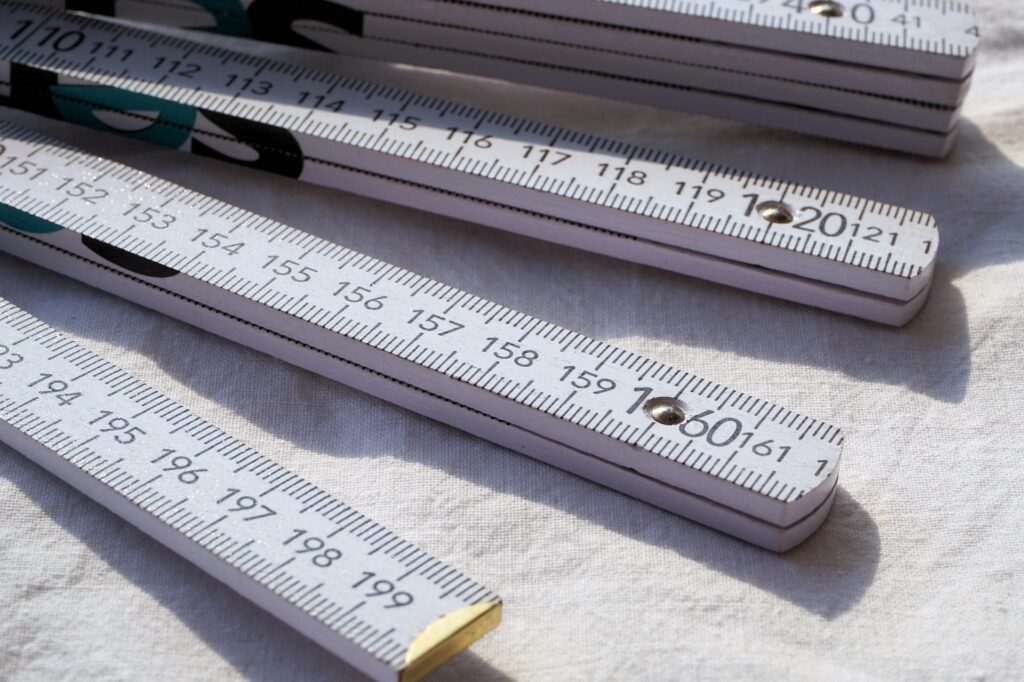
Wood is the best material to choose from when looking for a woodworking folding ruler as wood-to-wood contact typically won’t scratch or damage your craft in progress.
Fiberglass Folding Ruler
An exciting factor that makes fiberglass folding rules stand out is that it is immune to cold because of the implementation of glass fiber. Aside from being durable, they are waterproof and do not swell in wet conditions compared to wooden folding rules, making them perfect for outdoor use.
Aluminum Folding Ruler
The aluminum folding rules are considered the right pick if you are very particular about accuracy. Its precision is regarded as an EC class II (professional measurement type with low error probability). Also, the aluminum material makes the ruler flexible, scratch-proof, oil repellent, heat, and weather-resistance.
Inside Reading vs. Outside Reading folding rulers
Inside reading or outside reading folding rulers, which one is best for your woodworking project? Let’s take a more detailed look at each type of folding ruler:
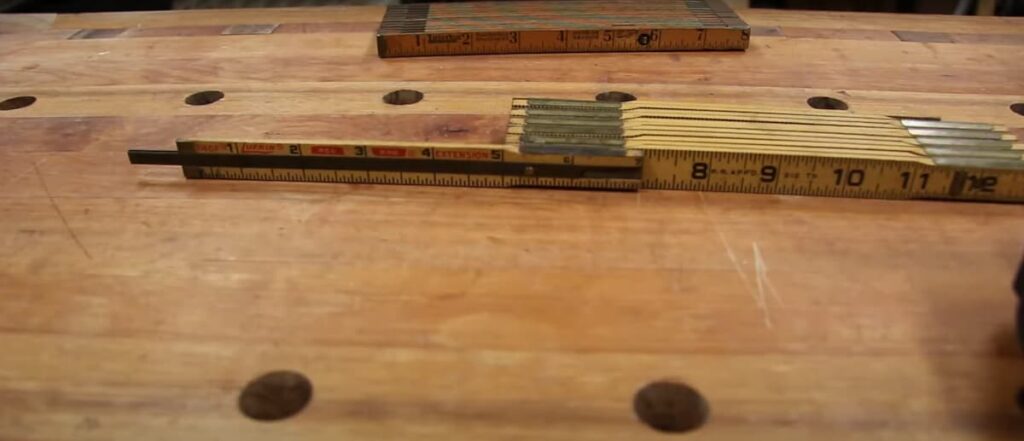
Inside Reading
Inside reading folding rulers are uniquely designed to measure accurate dimensions of the inside of any object like boxes, drawers, windows, dressers, and more. But what makes inside reading the idle ruler? The inside reading folding ruler comes with an in-built brass slide. So when you put the ruler inside an object, you can extend the brass slide towards the remaining area to which the ruler can’t gain access. That way, you can estimate the measurement by simply calculating- Length of rule units + the length of the extension. Here are more detailed instructions on how to measure inside dimensions with a folding ruler.
Outside Reading
On the outside reading folding ruler, measurement happens from left to right and front to back due to the numerals upright. Outside reading helps create precise lines and angles, and for that reason, they come in 90°-180° joints, which are firm and last long. Since outside reading calculates the outer areas, the ruler is made to be rigid and sturdy, water and chemicals-resistant.
Why Use a Folding Ruler Instead of a Measuring Tape?
Let’s take a look at some of the advantages and disadvantages of using a folding ruler for your woodworking projects instead of a more traditional way of measuring lengths such as a measuring tape.
Measurement Tape
Pros
- Compact and structured for use
- Capable of measuring both inside and outside spaces
- Versatile as it can be used to measure lengths around the house
Cons
- May not provide precise measurements for straight lines due to its flexibility.
- Requires both hands or may require a second person for measurement.
- Spring tapes tend to spring back if not locked.
- Faces difficulties in placing the tape horizontally against an object, leading to failure of accurate reading.
- As the tape comes with a hook, once damaged, it affects the measuring accuracy.
- It gets rusty and corrodes when exposed to wet conditions.
Folding Ruler
Pros
- Due to the incorporated extender in the ruler, inside measurements are more convenient.
- Provides straight measurement because of the ruler’s rigidity.
- Can get accurate measurements by placing gradation marks against flat surfaces.
- While measuring angles, you can use a folding ruler alongside a protractor.
Cons
- Not applicable for estimating circles or curves.
- With time, the ruler’s hinges get loose, leading to less accurate measurements.
- The shape of the wooden folding ruler changes due to exposure to moisture.
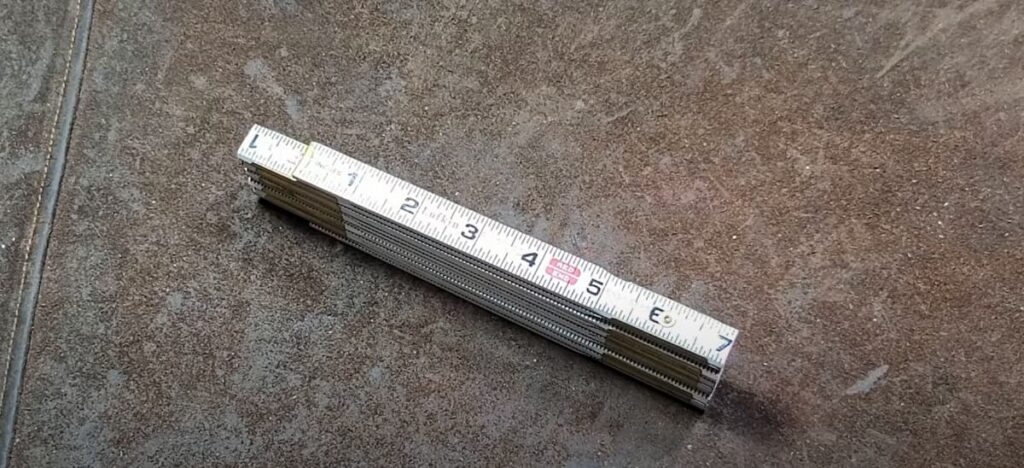
Additional Folding Ruler Usage Tips
Previously, we have discussed how to use a folding ruler. Now we have some other tips on how to use a folding ruler. So let’s proceed.
1. How to Scribe a Line
Place the ruler on the desired object and lock it between your thumb and index finger on the required measurement. Take a pencil, set it on the tip of the ruler, and pull them through until the necessary length and your straight line is ready.
2. How to Scribe a 90-Degree Line
Start by adjusting your ruler, and with its sections, make a triangular-shaped square. Put one corner of the triangle’s 90° at the boundary of the wood. Then you can make use of the other 90° corner as your reference to create a line.
3. How to Scribe a Circle
Open the ruler to the required length and place your finger down at the ending point. Place the pencil on the starting point of the ruler and push it through the ark you want. If you want a more straightforward method, get a drill and drill a small hole at the starting tip of your ruler. Put the end of your pencil on the spot and push it through. The circle is ready!
4. How to Use a Protractor
With the help of the hole created while making a circle, calculate another 57.3cm and make another hole. Use the new hole as a mark and draw an ark by placing the pencil on the first hole and pulling through. Then bend the ruler, form an arch over your already drawn ark, and start marking each cm by the edge. In no time, your protractor is ready to measure angles.
5. How to Transfer a Bevel Angle
If you wish to create a circular angle, stretch the ruler to the radius and place the ruler at the circular point. You can then put your pencil’s tip at the ruler’s end and revolve it, which will mark the circle’s required radius.
Conclusion & our recommendation
The folding ruler still has managed to be one of the preferred measuring tools of most woodworkers. Why? It is hard to ignore that the folding ruler has been designed for precise measurement of furniture, and other objects with straight angles that are otherwise hard to measure accurately.
Folding rulers are easy to use, and hence, beginners need not worry. So make sure to check the list of best folding rulers provided. And keep an eye on the Lufkin X46SLN Wood Rule. The product comes in high-quality, attractive features and is pocket-friendly. With that, hopefully, your woodworking looks perfect! All thanks to the folding ruler.
